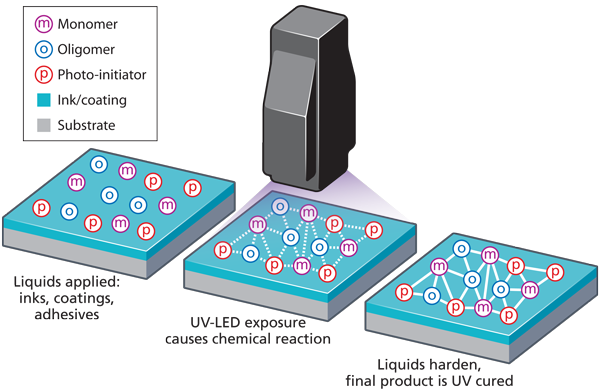VAT nr: NL140652802B01
Bank: NL140652802B01
IBAN: NL61 INGB 0006 8770 95
BIC: INGBNL2A
UV-LED curing refers to a technique that utilizes energy output from the LEDs in the UV spectrum to treat inks, coatings, adhesives, and other UV-curable materials. The energy generated by the UV light triggers a chain reaction resulting in polymerization of the material, thus hardening or curing the material (Figure. 1).

Traditionally, mercury-based UV lamps have been utilized for curing, but now more energy-efficient and environmentally-friendly LED-based UV technology has proven a superior solution for many applications. LED curing technology uses semiconductor-based LEDs to project the UV light when an electric current is passed through them. When an LED is forward-biased, electrons are able to recombine with electron holes within the device, thus releasing energy in the form of photons.
The color of the light emitted or corresponding energy of the photon is determined by the energy gap of the semiconductor material. A number of companies that make LEDs used for general illumination also make LEDs that radiate in the UV spectrum. It is an accepted fact for many industries that LED lamps provide many advantages including lower energy consumption, longer lifetime, improved robustness, smaller form factor, and faster on/off switching. Those advantages are also important in curing applications.
UV-LED curing technology has advanced significantly in the past few years and is now readily available for a variety of applications in printing, coatings, and adhesives. There are many benefits driving companies to move toward acceptance of UV-LED technology such as higher productivity and a more environmentally-friendly solution, which more and more end customers are demanding. As manufacturers are developing UV-LED curing systems, knowing how the key sub-components work together will help in creating the optimum system and thereby reducing the overall environmental impact of the process and at the same time maintaining or improving productivity and product performance. An efficient UV curing process needs to match the output of the UV curing lamps to the absorption
characteristics of the UV chemistry. Typically, the chemistry formulator will recommend the energy
density (mJ/cm2) and wavelengths (nm) needed for curing. Often lab testing confirms chemistry
performance and UV lamp specifications. UV chemistries are available for nearly any application as a
single-component formulation that does not require mixing. Depending on the specific application, the UV formulator can adjust viscosities to meet the needs of the ink, coating or adhesive application method such as screen-printing, roller coating, spraying, or precision adhesive dispensing. Sometimes, if there are shadow areas where the UV energy cannot reach (UV curing is line-of-sight), a process can still gain many of the advantages of UV curing by using a dual-cure chemistry that combines UV and heat or moisture to cure. UV LED curing lamp systems consist of multiple sub-components which taken together can be used to define the system’s overall performance.
The key design sub-components are outlined below. Examining these components in closer detail and their interactions and interdependencies will provide the reader with a better understanding of how UV LED curing lamps are not created equally.
| Component | Purpose |
| LED | Solid-state component that generates UV light. |
| Array | Grouping of LEDs to maximize UV output to achieve desired curing rate. |
| Thermal Cooling | A properly designed thermal management system for the removal of heat generated by LED array to insure low operating temperature and long life. |
| Optics | The shaping, molding, reflecting, and guiding of the UV LED light to insure maximum light reaches the media. |
Regardless of the LED, array, thermal and optics design employed, the end result that matters to end-users is that there material is cured. The two measurement parameter for this are: Peak Irradiance and Dose, as outlined below. These two parameters work together and understanding their measurement method will allow OEMs and end-users to properly characterize the UV LED curing system.
| Peak Irradiance | Dose | |
| Definition | Radiant power per-unit-area | Radiant power per area per unit time |
| Measurement | Watt per centimeter squared(W/cm2) | Joules/cm2 or mJoules/cm2 |
| Impacted by | Distance from material | Material speed Emitting window size |





